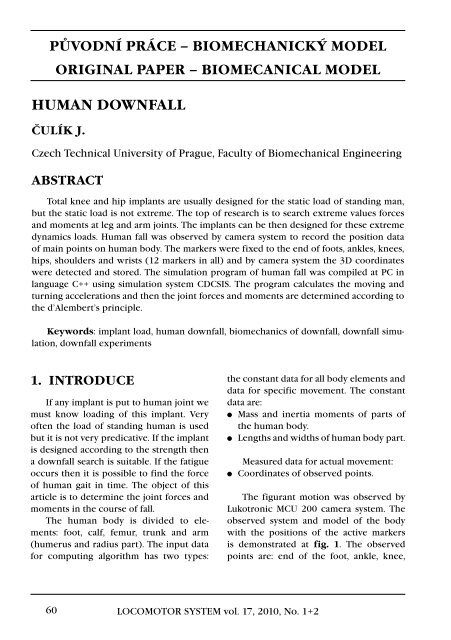1+2/2010 - SpoleÄnost pro pojivové tkánÄ›
1+2/2010 - SpoleÄnost pro pojivové tkánÄ›
1+2/2010 - SpoleÄnost pro pojivové tkánÄ›
Create successful ePaper yourself
Turn your PDF publications into a flip-book with our unique Google optimized e-Paper software.
původní práce – biomechanický modeloriginal paper – biomecanical modelHuman downfallČulík J.Czech Technical University of Prague, Faculty of Biomechanical EngineeringAbstractTotal knee and hip implants are usually designed for the static load of standing man,but the static load is not extreme. The top of research is to search extreme values forcesand moments at leg and arm joints. The implants can be then designed for these extremedynamics loads. Human fall was observed by camera system to record the position dataof main points on human body. The markers were fixed to the end of foots, ankles, knees,hips, shoulders and wrists (12 markers in all) and by camera system the 3D coordinateswere detected and stored. The simulation <strong>pro</strong>gram of human fall was compiled at PC inlanguage C++ using simulation system CDCSIS. The <strong>pro</strong>gram calculates the moving andturning accelerations and then the joint forces and moments are determined according tothe d’Alembert’s principle.Keywords: implant load, human downfall, biomechanics of downfall, downfall simulation,downfall experiments1. IntroduceIf any implant is put to human joint wemust know loading of this implant. Veryoften the load of standing human is usedbut it is not very predicative. If the implantis designed according to the strength thena downfall search is suitable. If the fatigueoccurs then it is possible to find the forceof human gait in time. The object of thisarticle is to determine the joint forces andmoments in the course of fall.The human body is divided to elements:foot, calf, femur, trunk and arm(humerus and radius part). The input datafor computing algorithm has two types:the constant data for all body elements anddata for specific movement. The constantdata are:l Mass and inertia moments of parts ofthe human body.l Lengths and widths of human body part.Measured data for actual movement:l Coordinates of observed points.The figurant motion was observed byLukotronic MCU 200 camera system. Theobserved system and model of the bodywith the positions of the active markersis demonstrated at fig. 1. The observedpoints are: end of the foot, ankle, knee,60LOCOMOTOR SYSTEM vol. 17, <strong>2010</strong>, No. <strong>1+2</strong>
















